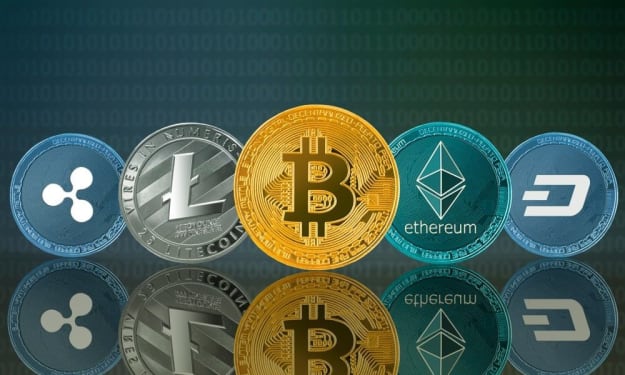Blockchain Technology
What is Blockchain, and How does it function?

What is Blockchain?
Through the use of decentralization and cryptographic hashing, blockchain, also known as Distributed Ledger Technology (DLT), makes the history of any digital asset unalterable and transparent.
A Google Doc is a good analogy for understanding blockchain technology. When we produce a document and share it with a group of individuals, instead of being duplicated or transferred, the document is disseminated. This provides a decentralized distribution chain in which everyone has simultaneous access to the document. No one is locked out while waiting for another party to make changes, and all changes to the document are logged in real time, making them entirely transparent.
Of course, blockchain is more involved than a Google Doc, but the comparison is useful because it highlights three key concepts.
Blocks, nodes, and miners are the three main concepts in blockchain.
Block
Every chain is made up of numerous blocks, each of which contains three basic elements:
The information contained in the block.
A nonce is a 32-bit whole number. When a block is constructed, a nonce is generated at random, which then generates a block header hash.
The hash is a 256-bit number that is associated with the nonce. It has to begin with a large number of zeros.
A nonce generates the cryptographic hash when the first block of a chain is formed. Unless it is mined, the data in the block is regarded signed and irrevocably linked to the nonce and hash.
Miners
Mining is the process by which miners add new blocks to the chain.
Every block in a blockchain has its own unique nonce and hash, but it also refers to the hash of the previous block in the chain, making mining a block difficult, particularly on big chains.
Miners utilize specialized software to solve the exceedingly difficult math issue of generating an acceptable hash using a nonce. Because the nonce is only 32 bits long and the hash is 256 bits long, there are around four billion nonce-hash combinations to mine before finding the proper one. Miners are considered to have discovered the "golden nonce" when this happens, and their block is added to the chain.
Making a change to any block earlier in the chain necessitates re-mining not only the affected block, but all subsequent blocks as well. This is why manipulating blockchain technology is so tough. Consider it "safety in math," because identifying golden nonces takes a long time and a lot of computational resources.
When a block is successfully mined, all nodes in the network acknowledge the change, and the miner is compensated financially.
Nodes
Decentralization is one of the most essential concepts in blockchain technology. The chain cannot be owned by a single computer or entity. Instead, the nodes connecting to the chain form a distributed ledger. Any type of electronic equipment that saves copies of the blockchain and keeps the network running is referred to as a node.
Every node has its own copy of the blockchain, and in order for the chain to be updated, trusted, and confirmed, the network must algorithmically approve any newly mined block. Every action in the ledger can be easily reviewed and examined since blockchains are transparent. A unique alphanumeric identification number is assigned to each participant, which is used to track their transactions.
The blockchain's integrity is maintained and users' trust is built by combining public data with a system of checks and balances. In a nutshell, blockchains are the scalability of trust through technology.
The Beginning of Blockchain's Technological Rise (Cryptocurrencies)
The most well-known (and perhaps most contentious) application of blockchain is in cryptocurrency. Cryptocurrencies, such as Bitcoin, Ethereum, and Litecoin, are digital currencies (or tokens) that may be used to purchase goods and services. Crypto, like a digital version of
cash, may be used to purchase everything from lunch to a new home. Unlike cash, crypto relies on blockchain to serve as both a public ledger and a stronger cryptographic security mechanism, ensuring that online transactions are always recorded and protected.
To date, there are around 6,700 cryptocurrencies in the globe, with a total market capitalization of nearly $1.6 trillion, with Bitcoin accounting for the vast majority of the value. Over the previous few years, these tokens have grown in popularity, with one Bitcoin being worth $60,000. Here are some of the primary reasons why cryptocurrencies are suddenly gaining popularity.
- Because each cryptocurrency has its own irrefutable identification number that is linked to one owner, the security of blockchain makes theft considerably more difficult.
- The necessity for customized currencies and central banks is reduced by crypto. With blockchain, crypto may be transmitted to anybody, anywhere in the world, without the need for currency conversion or central bank intervention.
- Speculators have been driving up the price of crypto, particularly Bitcoin, allowing some early adopters to become billionaires. Whether this is a beneficial or not has to be seen, as some critics argue that speculators aren't thinking about the long-term benefits of crypto.
- The idea of a blockchain-based digital currency for payments is gaining traction among huge organizations. Tesla notably declared in February 2021 that it will invest $1.5 billion in Bitcoin and use it as payment for its cars.
Of course, there are numerous valid objections against digital currencies based on blockchain technology. To begin with, cryptocurrency is not a highly regulated market. Many governments were quick to embrace cryptocurrency, but few have formalized rules in place to manage it. Furthermore, due to the aforementioned speculators, cryptocurrency is extremely volatile. Bitcoin was valued at roughly $450 per token in 2016. In 2018, it surged to approximately $16,000 per token, dropped to around $3,100, and has recently risen to over $60,000. Because of the lack of stability, some people have become extremely wealthy, while the rest have lost tens of thousands of dollars.
It remains to be seen whether digital currencies are the way of the future. For the time being, it appears that blockchain's stratospheric rise is more rooted in truth than sheer hype. Blockchain is showing potential outside of Bitcoin, despite the fact that it is still making progress in this brand-new, highly adventurous industry.
Ethereum Blockchain Advances Beyond Bitcoin
Blockchain has long been linked with cryptocurrencies, but the technology's transparency and security have seen rapid use in a number of fields, much of which can be traced back to the Ethereum blockchain's creation.
Vitalik Buterin, a Russian-Canadian engineer, issued a white paper in late 2013 proposing a platform that included standard blockchain features with one major difference: computer code execution. The Ethereum Project arose as a result of this.
Developers can use the Ethereum blockchain to create sophisticated programs that can communicate with one another.






Comments
There are no comments for this story
Be the first to respond and start the conversation.